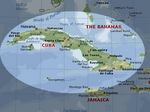By Jefferson Morley washingtonpost.com
Staff WriterFriday, July 27, 2007; 3:02 PM
What is the "wet-foot, dry-foot" policy?
This is the informal named given to a 1995 agreement under which Cubans migrants to the United States who are intercepted at sea ("wet feet") are sent back to Cuba or to a third country while those who make it to U.S. soil ("dry feet") are allowed to remain in the United States. The policy, formally known as the U.S.-Cuba Immigration Accord, has been written into law as an amendment to the 1966 Cuban Adjustment Act.
How does the Coast Guard enforce this policy?
The Coast Guard uses patrol boats, cutters and aircraft to patrol the seas and skies around southern Florida. Cubans intercepted at sea are interviewed by the U.S. Citizenship and Immigration Service which decides whether they have a well founded fear of persecution and are thus eligible for asylum in a third country. If not, they are repatriated to Cuba.
What happens to Cubans who make it to U.S. soil?
After one year they are eligible to apply for a change in legal status that makes them eligible for an immigrant visa, permanent residence, and, eventually U.S. citizenship. The policy applies to undocumented aliens from Cuba only. Undocumented Haitian or Dominican migrants who reach U.S. shores are not automatically eligible for immigrant visas, or permanent residence, only Cubans.
What happens to migrants returned to Cuba?
In 1994, Cuba agreed to take no action against returnees as a consequence of their attempt to immigrate illegally, as long as they did not face other criminal charges. The U.S. Interests Section monitors Cuban compliance with this provision by visiting the returnees throughout Cuba. In 2006, the State Department reported that "in practice some would-be migrants experienced harassment and discrimination," citing one example. Cuba notes that illegal immigration is a crime under Cuban law. Related: 2007 Report on Cuba by Bureau of Democracy, Human Rights, and Labor.
Do we know how many die trying to get here?
Nobody knows for sure. Neither the Coast Guard nor the State Department nor human rights groups keep statistics on Cuban fatalities at sea. During the balsero crisis of 1994 there were estimates that anywhere from 25 percent to 75 percent of all those who attempt to migrate were dying at sea. As human smugglers have begun using more sophisticated boats in recent years, fatalities at sea may be falling but no one really knows.
How might restrictions change in the future?
The "wet foot, dry foot" policy, while resented by Cuba, has served the interests of both countries for more than a decade. It has prevented recurrence of massive uncontrolled migration that the United States fears and it established the kind of more normal migration arrangements that Cuba seeks. U.S. Congress is debating more modest proposals to loosen the current ban on travel between the United States and Cuba. Changes in migration policy probably depend on changes in the larger relationship between Washington and Havana.
var comments_url = "http://www.washingtonpost.com/wp-dyn/content/article/2007/07/27/AR2007072701493_Comments.html" ;
var article_id = "AR2007072701493" ;
Monday, August 20, 2007
Subscribe to:
Post Comments (Atom)

No comments:
Post a Comment